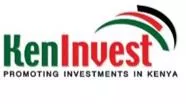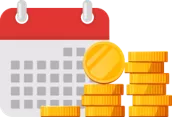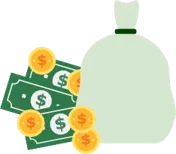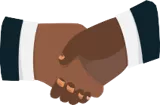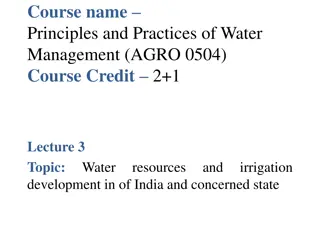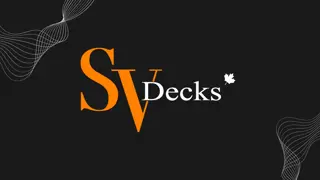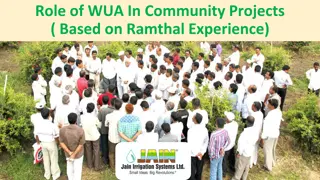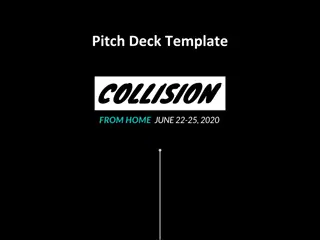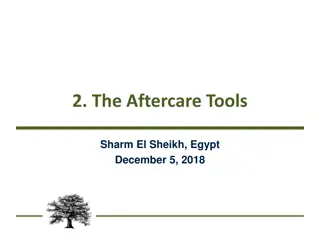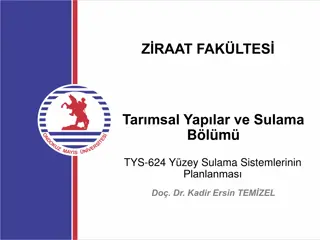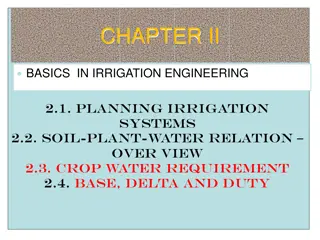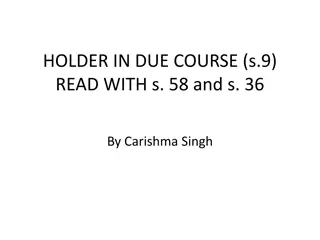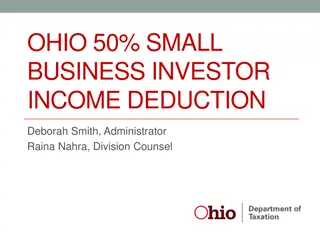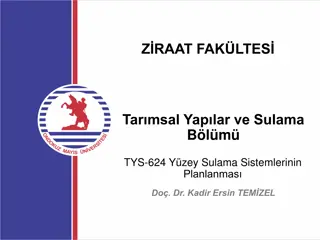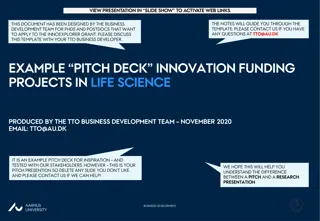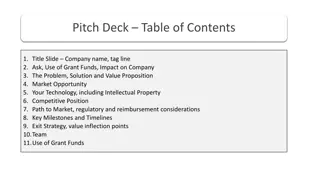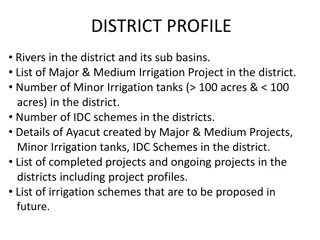Lower Muranga Small Holder Irrigation Project Investor Pitch Deck
Agricultural sector crucial for Kenya's economy. Proposed irrigation project aims to boost farm output, food security, and economic growth. Seeking investors for $102.5 Mn investment in irrigation and hydropower infrastructure across Muranga catchment area. Projected positive NPV and IRR, benefiting 33,000 customers and over 50 million Kenyans. Includes dam development and mini hydropower generation.
Uploaded on Sep 13, 2024 | 0 Views
Download Presentation

Please find below an Image/Link to download the presentation.
The content on the website is provided AS IS for your information and personal use only. It may not be sold, licensed, or shared on other websites without obtaining consent from the author. Download presentation by click this link. If you encounter any issues during the download, it is possible that the publisher has removed the file from their server.
E N D
Presentation Transcript
LOWER MURANGA SMALL HOLDER IRRIGATION PROJECT Investor Pitch Deck February, 2023
EXECUTIVE SUMMARY The Agricultural sector has remained the backbone of Kenya s economic development over the years. The sector s contribution to the country s GDP has at 30% on the average for the past 10 years. Given that the sector is heavily dependent on rain fed Agriculture with drought episodes having steep negative impact on production, the potential is far from being realized. Farm output in the target region can be buoyed throughout the year through irrigated Agriculture. This addresses the issue of food security and positively impacts the Kenyan economy. Growing economy, with investment in the Agricultural sector as a top priority USD 102.5 Mn initial investment Seeking investors and private sector partners to invest USD 102.5 Mn in initial investment covering 2 key focus areas; irrigation and hydropower infrastructure as well as dam development spread across 5 clusters representing 5 regions within the larger Muranga catchment area. USD The project is expected to reach an average Net Present Value of USD 11.76 Mn across the 5 regional clusters, a positive measure on the project s viability.. The estimated average IRRs 26.67% higher that the considered cost of capital of 10%. Positive NPV and IRR Direct beneficiaries of the project comprise 33,000 customers spread across the 5 clusters of lower Muranga region. The farm produce that will accrue courtesy of irrigated Agriculture will serve over 50 million Kenyans with more left to spare for the export market after value addition from light as well as large industries driven by the 2.5 MW hydropower. The project feasibility thus presents a positive outlook post project implementation with both result areas having ready market. The dam- hydropower impact 2
Project Architecture Proposed Investment Tana and Athi Rivers Development Authority (TARDA) is seeking to attain water security and climate resilient communities by curving out investment opportunities in 3 key sectors: Water, Agriculture and Energy. Components/ Key Focus Areas Dam targeted at 8000 ha irrigation scheme 2.5 MW mini hydropower generation to supply power for industrial use in Agricultural value addition The irrigation project that is expected to cover a net area of 8000 ha is integrated with hydropower expected to generate 2.5 MW. The number of enterprises in agricultural value chains, water and energy is expected to increase. Proposed Development Plans Based on the economic and financial consideration assumed in the analysis, the $102.5 Mn investment in the Lower Murang a area is worthwhile. This is so because the area gives positive NPVs and generates internal returns at a rate (IRR) higher than the considered cost of capital of 10% at 11.6 Mn and 26.67% respectively. Irrigation infrastructure to unlock 3 seasons per year Agri -Enterprise focused on mixed farming The Irrigation and Hydropower infrastructure component is projected to cost $ 60.99 Mn while the Dam will cost 41.55 Million in capital investment. Source: TARDA 2014 2018 strategic plan, TARDA feasibility study for lower Muranga Small Holder Irrigation 5
Locational competitive advantage established as a leading logistics hub with well developed infrastructure 4 Stable economic growth and liberalization ..and it is becoming easier to conduct business in Kenya Ranked 3rd on overall ease of doing business in Sub-SaharanAfrica GDP in 2021 sustaining increased growth for the past 10 years Number of international airports with capacity to handle large cargo to international markets for the envisioned agri- produce $110.35 Bn 1st on getting credit GDP per capita representing 73.9% growth since 2010 $2006.8 1st 8000 ha on protecting minorityinvestors Size of land earmarked for irrigated agriculture on dry parts of lower Muranga 2nd In untapped export potential according ITC. Presenting massive opportunity for investors on resolving solvency $4.1 Bn Development options place emphasis on efficient and economically viable water supply, distribution and application technologies over the long term. 3rd on getting electricity In market value based on preferential trade agreements signed by Kenya opening markets with 1.7 bn people in population Stable policy framework as the country looks into advancing ease of doing business $40 Tn 4
Problem Statement Weather Patterns The targeted acreage is currently commercially underutilized owing to the weather patterns in lower Murang a. The feasibility study presents a positive outlook on commercial agricultural viability. Domestic Water Supply The area has no portable water and residents use water from well, springs and rivers. Energy Access There are 33,861 households out of 255,696 households with electricity connections. A negligible number, less than 1per cent of households use solar energy. Much needs to be done to expand rural electrification programme to increase the proportion of households with access to electricity 5
Current crop yield Av yield/acre (kg) 6000 5000 5000 4500 4000 3000 3000 2500 2000 1500 1000 1000 675 400 360 270 270 220 90 75 0 Av yield/acre (kg)
Expected yield per ha after intervention Tons/ha TONS/HA tons/ha 50 60 40 50 40 30 30 20 20 Tons/ha 10 10 tons/ha 0 0 Tons/ha
The project investments costs for all clusters Mirira/Maragua Ridge Item/Cluster Kambiti Ithanga/Kakuzi Kamahuha Makuyu Totals 2123 112 1259 282 769 Areas in ha (without storage) (without storage) (without storage) (without storage) (with storage) 0 Preliminaries and generals 2,806,698.03 148,068.86 1,664,452.58 372,816.23 1,016,651.34 6,008,687.03 Intake Works and sedimentation Tank 1,124,963.51 59,348.05 667,135.69 149,429.92 407,487.96 2,408,365.13 Roads, River & Gully Crossings 509,165.81 26,861.31 301,949.96 67,632.95 184,431.71 1,090,041.74 Water Conveyance, distribution and application System 19,107,257.33 1,008,013.58 11,331,152.61 2,538,034.18 6,921,093.21 40,905,550.91 Hydropower project 0.00 4,414,625.32 2,338,764.05 3,819,991.82 0.00 10,573,381.19 GRAND TOTAL 23,548,084.69 5,656,917.12 16,303,454.88 6,947,905.09 8,529,664.22 60,986,026.00
Assumption for financial Analysis Project operation, maintenance and replacement costs presented as a percentage of their respective investment costs: Intake works and Sedimentation tank-2.5% Roads, river and gully crossings -2% The investment cost is assumed over 3 years as follows: 40% in both year 1 and year 2 and 20% in year 3 Water conveyancing system-2% Both the costs of Project replacement and environmental mitigation are taken each at 5% of the project costs Assumptions Development of crop production: Switching from mainly subsistence rain fed production to It is assumed that the economic lifespan of the scheme is 25 years after finalizing the construction activities (excluding 1-year defects period) irrigated subsistence and commercial vegetable and cereals production will be a major change for the farmers.
Summary of farm incomes Projected incomes with Current incomes without Benefits from hydro project ($) Incremental farm incomes ($) Item/Cluster project ($) project ($) Mirira/Maragua Ridge 659,850,6.92 8,166,0.76 0.00 651,684,6.15 Kambiti 165,883,7.87 3,926,0.13 26,078,1.07 188,035,8.81 Ithanga/ Kakuzi 538,841,4.11 5,525,5.44 8,246,5.62 541,562,4.28 Kamahuha 205,282,0.81 16,109,3.88 25,805,2.25 214,977,9.18 Makuyu 470,713,3.59 10,623,8.08 0.00 460,089,5.51
Results for discounted measures IRR (%) NPV 18,080,325.23 16,860,206.39 22, 17% 35, 26% 12,246,730.32 24.52, 18% 4,950,179.22 4,692,518.25 22.49, 17% 29.31, 22% Mirira/Maragua Ridge Kambiti Ithanga/Kakuzi Kamahuha Makuyu-Pundamilia NPV
The analysis shows that, based on the economic and financial consideration assumed in the analysis, investing in all clusters is worthwhile. Conclusion The clusters give positive NPVs and generate internal returns at rates (IRR) higher than the considered cost of capital of 10% 12





